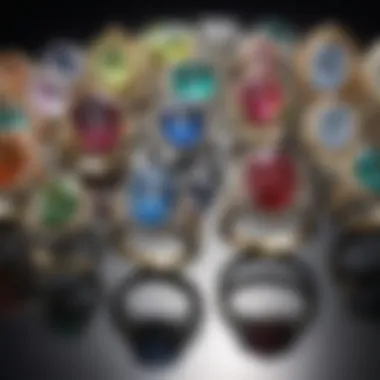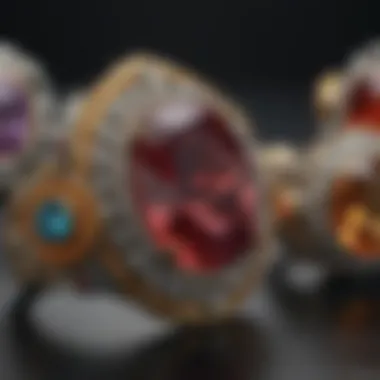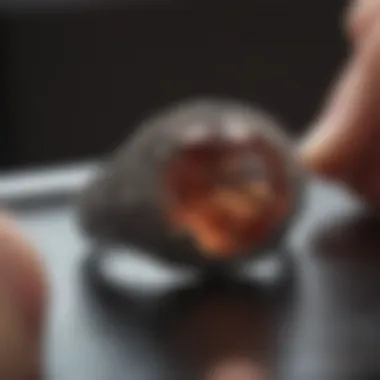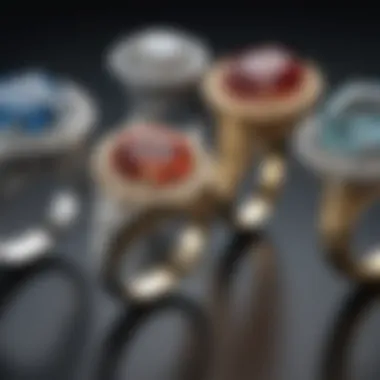Trends in Gemstone Jewelry: The Rise of Larger Rings


Intro
The world of gemstone jewelry is not just about sparkle and shine; it's a field rich with history, culture, and evolving design philosophies. In recent years, the trend of increasing ring sizes has caught the attention of both jewelers and consumers alike. As rings become bolder and larger, understanding the underpinnings of this shift is essential for anyone engaged in the realm of gemstone adornments.
Rings, particularly those embellished with gemstones, have always held a special place in human expression. Whether as symbols of love, status, or personal style, they speak volumes about their wearers. The growing inclination towards larger sizes in rings offers a window into changes in societal values, personal preferences, and fashion trends. Exploring the dynamics behind these shifts not only sheds light on the current market but also gives a glimpse into what might be on the horizon for the gemstone jewelry industry.
Understanding Ring Sizes
The realm of gemstone jewelry is not just about aesthetics, but also about how well they fit on the wearer's finger. Understanding ring sizes is foundational for both jewelers and consumers, as improper sizing can lead to discomfort and, at times, the dreaded loss of a treasured piece. Several factors influence this intrinsic concept of sizing, making it crucial to grasp its depths.
Ring size isn't merely a number; it reflects personal preference, cultural significance, and even fashion trends. By comprehending ring sizes, gem enthusiasts can appreciate the artistry behind each piece, and jewelers can enhance their offerings. Furthermore, accurate sizing is essential for ensuring that rings, especially those with gemstones, are secured properly and can be worn without issues.
The Basics of Ring Sizing
Getting down to the nitty-gritty, ring sizing really kicks off with a few basic principles. At its core, sizing is about measuring the circumference or diameter of the finger. The most common method employs a simple chart based on millimeters, where each corresponding number represents a specific size. However, everyone has unique finger shapes, making it essential to consider both the width of the ring and the shape of the finger. An oversized ring can slip off and vanish, while a too-tight fit could be an exercise in frustration.
Let’s break down some ways to measure your ring size:
- String Method: Wrap a piece of string around your finger, mark where it overlaps, and measure the length against a ruler.
- Printable Size Charts: Many jewelers offer downloadable charts that let you compare your finger’s circumference to established sizes.
- Professional Measures: Visiting a jeweler can yield the most accurate reading since experts often have specialized tools.
Each method has its own merits, so it's wise to select one that's suitable for your situation.
The Significance of Accurate Measurements
Now, why do accurate measurements matter? Well, let’s think about it. With the rise of custom designs and personalized jewelry, understanding how crucial a fit can be is central to both creation and ownership. A ring that fits can confidently accompany its wearer through day-to-day adventures and festive occasions alike.
Inaccuracies can lead to dissatisfaction, with clients sometimes opting to return their purchases. Jewelers often face the headache of adjusting or remaking items, adding unnecessary costs and time. Plus, when discussing engagement or significant pieces, the emotional weight of the perfect fit cannot be overlooked.
In essence, getting ring sizes right is an art in itself. As ring sizes are on the rise, this makes the understanding of sizing both practical and imperative for anyone delving into the world of gemstone jewelry.
"A ring isn't just a band of metal or an adornment; it's a statement, and it should fit just right."
As consumers and designers embark on this journey, it’s vital to remember that the nuance behind measurements can greatly affect satisfaction and the overall experience with gemstone jewelry.
Historical Insights on Ring Sizes
Understanding the historical context of ring sizes is crucial. Not only does it provide a backdrop against which current trends can be observed, it highlights the evolution of societal norms and values associated with gemstone jewelry. There’s a significant connection between history and the way people perceive and wear rings today. Each shift in sizing reflects broader cultural and fashion trends, with a direct influence on individual preferences as well as industry standards.
The journey of ring sizing shows how trends can both mirror and mold societal perspectives, creating a tapestry of what rings signify across different periods. Delving into this history not only enriches our understanding but also sheds light on why certain styles and sizes continuously resurface in contemporary designs.
Evolution of Ring Sizing Through the Ages


Historically, rings served much more than just an aesthetic purpose; they were symbols of status and identity. In ancient civilizations, rings were often designed to convey authority. Take the Roman signet rings, for example. They were worn by the elite to stamp documents, marking their ownership and seal of approval. In those times, size was often dictated by the materials available and the intended function of the piece.
As we moved into the Middle Ages, the craftsmanship behind rings flourished. Goldsmiths began experimenting with designs that emphasized stone size and intricate detailing. The availability of gemstones was limited, and thus, the size of the stones tended to reflect rarity and wealth. Bigger stones symbolized greater affluence, and the perception of beauty began to shift toward larger, more elaborate designs.
Fast forward to the 20th century, and we witness a dramatic change in jewelry trends spurred by social movements. The rise of the middle class meant that gemstones became more accessible, leading to diverse preferences in sizes and designs. During the 1950s and 60s, the focus on larger, sparkling engagement rings became a hallmark of romance and commitment, a trend fueled by marketing efforts from jewelers trying to standardize the 'perfect' proposal.
Cultural Variations in Ring Dimensions
Dimensions of rings are not universally understood; they vary greatly across cultures. For instance, the Japanese have a tradition of gifting rings that often lean towards the more subtle and understated. In contrast, Western societies may favor bold designs featuring larger stones—expressions of individuality and personality. Each culture’s approach to ring size tells a story of values, beliefs, and aesthetics unique to its people.
Moreover, the significance of size can differ even within a single culture. In some communities, larger rings are considered symbols of love and devotion, while in others, they might be perceived as gaudy or extravagant. This disparity highlights how personal tales intersect with broader cultural narratives.
"Rings are not just pieces of jewelry; they are carriers of personal stories and cultural legacies."
As we observe, the evolution of ring sizing reflects not just changing trends but deep-rooted cultural perceptions that have adapted over time. The exploration of historical insights on ring sizes provides a foundation for understanding contemporary preferences and styles in gemstone jewelry. It invites enthusiasts and industry professionals alike to appreciate the richness of history in every ring they encounter.
Factors Driving Increases in Ring Size
Understanding the factors driving increases in ring size is quite crucial for any serious discussion surrounding gemstone jewelry. It dives into the intersection of consumer behavior, fashion influences, cultural shifts, and societal norms. With jewelers adjusting their offerings to cater for these growing desires, knowing what fuels this trend can assist consumers and professionals alike. Factors such as fashion trends and cultural shifts play a pivotal role, providing insight not only into current preferences but also hinting at future directions in the world of gemstone jewelry.
Fashion Trends and Their Impact
Fashion trends are like a tide that ebbs and flows, sometimes quickly, and at other times, they may change slowly. Current trends often dictate what styles, colors, and yes, even ring sizes are in vogue.
Celebrity Influences
Celebrities are at the forefront of setting trends. The influence of high-profile figures—and their choices in jewelry—has an undeniable ripple effect on public preferences. When a beloved star showcases a dazzling oversized ring at an award ceremony, the reaction can be immediate. This surge in visibility can spark a desire among consumers to mimic those looks.
A notable example would be when Jennifer Lopez flaunted her impressive green diamond engagement ring on social media. Such moments reveal the key characteristic of celebrity influence: its power to inspire and shape consumer behavior. The advantage of these influences is that they create a communal excitement around larger rings. Yet, it can also lead to excessive focus on the showy nature of the pieces, oversimplifying the deeper meanings behind meaningful purchases.
Seasonal Trends
Seasonal trends can also sway ring sizes. Different times of the year bring with them fresh styles and colors, reflected in jewelry collections around the world. For example, summer weddings often embrace lighter, more elegant themes, leading to the popularity of slimmer bands and subtle gems. Conversely, in the winter months, there's a tendency to move toward bolder and larger pieces.
This cyclical characteristic of seasonal trends offers a beneficial angle for jewelers, as they can adjust their collections accordingly to meet fluctuating demands. However, one must be cautious. If a jeweler is not mindful of the direction of these seasonal desires, they might just find themselves caught off guard in a marketplace that requires constant adaptation.
Cultural Shifts and Their Influence
Cultural shifts represent a melting pot of evolving societal attitudes affecting lifestyle choices, including jewelry preferences. These shifts signal ongoing changes in how people view gemstones and their significance in life milestones.
Attitudes toward Gemstone Longevity


The increasing emphasis on sustainability and longevity has reshaped attitudes toward gemstone jewelry. People are beginning to appreciate the longevity of gemstones—often cherished for generations. The stone's lasting appeal often leads to the desire for larger or more notable pieces, seen as investments rather than fleeting fashion statements.
This growing appreciation for longevity enhances the sense of connection between the wearer and the piece, which becomes more than just a decorative item, it embodies memories and future potential. However, with this comes the challenge of ensuring ethical sourcing and sustainable designs that satisfy these more conscientious consumers.
Changing Norms in Jewelry Gifting
Finally, the changing norms in jewelry gifting also impact ring size trends. Engagements, anniversary celebrations, and special occasions have traditionally come with specific expectations around jewelry. However, as these celebrations evolve, so do the norms surrounding gifts. For instance, personalized and unique pieces are becoming more favored.
Individuals now tend to seek rings that reflect personal taste rather than conforming to traditional standards. This inclination can lead to larger, more customized sizes that cater to personal aesthetics. The unique character of these jewelry pieces may also heighten emotional value, further encouraging individuals to go for larger sizes. Yet such customization may strain budgets, and some may feel the pressure to overspend in the pursuit of uniqueness.
The Practical Consequences of Increased Ring Sizes
As ring sizes evolve, the implications stretch beyond mere aesthetics. We see shifts not only in design preferences but also in practical considerations every jeweler and customer should weigh. Increased ring sizes can influence everything from material choices, to production methods, and ultimately affect customer satisfaction. This critical discussion revolves around the balance between trends and timelessness, ensuring that personal style aligns with practicality.
Considerations for Jewelry Design
When jewelers embark on the creative journey of designing larger rings, the design intricacies become a paramount concern. Larger rings often mean more prominent gemstones, which can drastically alter the overall design aesthetics.
- Weight Distribution: Jewelers must consider how the larger size affects weight distribution. A ring that feels comfortable on the finger must be weighted properly to avoid slipping or repositioning.
- Proportions: A larger setting can necessitate rethinking proportions. Designers often explore how different styles—whether it’s a solitaire, halo, or three-stone setup—funnel visual appeal without overwhelming the wearer.
- Detailing and Embellishments: With bigger real estate, there is an opportunity to incorporate more intricate designs or additional embellishments. This could mean adding engravings or incorporating smaller accent stones, which can enhance overall charm or allure of the piece.
- Comfort Fit: Larger rings can encourage the use of comfort fit designs, where the inner band is slightly rounded to ensure a snug yet gentle fit. This aspect becomes more critical as sizes increase, ensuring that aesthetics do not jeopardize comfort.
Material Selection and Durability
Material choices become crucial when considering the increase in ring sizes. Both durability and aesthetics must be kept in mind to ensure that larger rings can stand the test of time.
- Metal Types: Jewelers often opt for stronger metals such as platinum or titanium when designing larger rings. These materials hold up against wear while contributing to the overall prestige of the piece.
- Gemstone Security: Larger rings not only incorporate more substantial stones but they also present challenges surrounding the security of these gems. Designers must ensure that prongs or settings are adequate to protect larger stones from potential loss.
- Anti-Scratch Measures: The wear and tear of everyday life can be demanding. Jewelers often look into coatings or treatments that can help mitigate scratches on larger, more visible surfaces, helping keep the ring looking pristine.
"Design isn’t just what it looks like and feels like. Design is how it works." – Steve Jobs
Ultimately, as ring sizes increase, designers must blend innovation with functionality. By doing so, they not only meet customer expectations but also elevate the overall experience of wearing gemstone jewelry. This balance ensures longevity, aesthetic beauty, and ultimately a more satisfying purchase for the discerning consumer.
Consumer Behavior and Preferences
In the sphere of gemstone jewelry, understanding consumer behavior and preferences is paramount. The choices individuals make regarding ring sizes are influenced by a multitude of factors—emotional ties, cultural significance, and changing fashion trends. As society evolves, so too do the perceptions around what constitutes an acceptable or desirable ring size.
Many individuals see rings, particularly engagement rings, as a representation of personal style and status. This symbolic nature pushes buyers to opt for sizes that not only reflect their taste but also project an image that others will admire. Larger rings can evoke a sense of prestige, making their allure undeniable in the eyes of many consumers.
Motivations Behind Size Selection
When it comes to selecting ring sizes, various motivations play a crucial role. Each potential ring buyer enters the market carrying a blend of personal expectations and societal pressures.
- Cultural Influences: In some cultures, bigger signifies better. An oversized rock might be perceived as a strong commitment to a partner. Conversely, minimalist or understated designs are gaining traction among a growing number of individuals, reflecting a shift towards values rather than mere materialism.
- Personal Expression: Many view their rings as extensions of their identity. A larger, more ornate ring may align with their adventurous spirit, while a simpler band may resonate with someone who prefers subtlety.
- Symbol of Status: For some, the size of the ring correlates directly with their personal or familial status. The desire to impress can influence decisions, leading to selections based on what is seen as socially acceptable or commendable.


"Rings are more than just jewelry; they tell a story that we often express through size and style."
- Trends and Celebrity Influence: Social media platforms, particularly Instagram and Pinterest, often showcase trendsetters flaunting oversized rings. This can have a ripple effect, driving consumers toward similar options in real life. Celebrity engagements bring attention to sizes that may not have been widely popular before, creating a cycle of bad influence in market decisions.
The Role of Engagement and Commitment
Engagement is typically viewed as a milestone event, and the size of the ring can sometimes have a profound impact on its perception. The overwhelming pressure of choosing the perfect engagement ring often causes a range of emotions, from excitement to anxiety.
- Symbolism of Commitment: A ring, especially an engagement ring, acts as a societal promise known as a 'commitment demonstration'. Many people feel that a larger ring directly translates into a greater level of devotion and dedication. Hence, the idea of increasing ring sizes aligns with a desire to emphasize this commitment.
- Long-term Investment: For some, the ring is not just a temporary adornment; it’s perceived as a family heirloom. Bigger, luxury pieces may be seen as investments worth passing down to future generations, making the size even more significant.
- Psychological Factors: The psychology of commitment plays a role as well. A more substantial ring may reinforce the feelings of tying oneself to another person. Some view size not merely as aesthetic value but as an embodiment of love and security.
As we navigate these trends in consumer behavior, it becomes clear that the motivations behind ring size selection are as varied as the individuals who wear them. By examining these facets, both jewelers and consumers can gain insights into the nuanced dance of preferences that shape the gemstone jewelry market.
The Future of Ring Sizes in Gemstone Jewelry
The increasing popularity of larger ring sizes heralds a shift that both consumers and jewelers must navigate. As we look ahead, it's clear that understanding the future of ring sizes goes beyond mere aesthetics; it touches upon deeper cultural significance and personal expression. Bigger rings don’t just cater to the eye; they speak volumes about individual priorities and values. The implications for buyers and jewelers revolve around adapting to these changes in demand while ensuring quality and comfort remain paramount.
Emerging Trends to Watch
As the landscape of jewelry continues to evolve, several emerging trends are worth keeping an eye on:
- Customization: More customers are seeking personalized pieces that reflect their unique stories. This trend invites designers to adopt more flexible sizing options that cater to individual needs, rather than adhering to standard sizes. Custom engagement rings that are not only larger but also tailored in design are becoming increasingly popular.
- Sustainability: Consumers are increasingly conscious about the sources of their materials. Rings that combine larger gemstones with ethically sourced materials will likely see a surge in interest. Eco-friendly practices in the jewelry industry resonate strongly with socially conscious shoppers.
- Mixing Materials: Innovative combinations of metals and gem types can create unique looks. We are likely to see designs that blend traditional gemstones with modern materials, creating larger, bolder styles that make a statement.
- Cultural Celebrations: More cultures are beginning to celebrate larger rings, evolving from a Western-centric view to a more global appreciation. This broader acceptance can drive demand in diverse markets.
Impact of Technology on Sizing Standards
Technology is dramatically transforming the way rings are designed and sized. Some important aspects include:
- 3D Printing: This technology allows for rapid prototyping of larger rings, enabling intricate designs that were once considered too complicated for mass production. Jewelers can create personalized pieces with precision, accommodating unique sizes and styles.
- Digital Fitting Tools: Augmented reality apps that let customers try on various ring sizes virtually are revolutionizing how buyers make decisions. This can lead to greater satisfaction as shoppers can better visualize how different sizes would look on them before making a purchase.
- Data Analytics: Jewelers can leverage data to understand trends and customer preferences better. This insight allows them to adjust inventory effectively and create designs that align with customer expectations, particularly in terms of size and style.
"The future of ring sizes in gemstone jewelry reflects not only what is en vogue, but also captures the essence of identity and expression."
Concluding Remarks
The topic of increasing ring sizes in gemstone jewelry holds significant weight in contemporary jewelry design and consumer preferences. As we reflected in the preceding sections, various facets of culture, fashion, and individual choices converge to influence this trend. Understanding these dynamics provides invaluable insights for both buyers and jewelers alike, offering a deeper context into the motivations behind size selections and design choices.
Recap of Key Insights
To summarize the essential elements discussed:
- Cultural Influences: Societal attitudes towards luxury and self-expression greatly shape preferences for larger gemstones. In cultures where jewelry conveys status or personal branding, the shift toward larger, more vibrant pieces is particularly pronounced.
- Fashion Trends: The impact of celebrity endorsements and fashion movements cannot be overstated. When high-profile figures sport larger rings, it sets a standard that many consumers seek to emulate.
- Consumer Behavior: As many buyers seek out uniqueness in their selections, this translates into a willingness to embrace bigger sizes. The notion that bigger often equals better resonates strongly, particularly in engagements and special occasions.
"In the world of jewelry, the size of a ring may be seen as a direct reflection of emotion, generosity, and intent."
Implications for Buyers and Jewelers
The implications of these insights are numerous:
- For Buyers: Understanding the cultural and personal significance of larger ring sizes can enhance the shopping experience. Buyers should consider not only current trends but also their personal style and the meaning behind their purchase. A larger ring often symbolizes commitment and love, but personal resonance matters more.
- For Jewelers: Jewelers must remain ahead of emerging trends to cater to a discerning clientele. Offering customization options, where clients can choose sizes and styles that reflect their unique personalities, becomes paramount. Furthermore, recognizing the implications of size on customer perception can inform inventory choices, marking a strategic approach to business.
- Sustainable Practices: In response to increasing demand for larger gemstones, jewelers may need to consider sustainable and ethical sourcing of materials, ensuring their practices align with growing ecological awareness among consumers.
In closing, the increasing trend of ring sizes is multifaceted, affected by cultural contexts, personal preferences, and broader fashion movements. For anyone involved in the realm of gemstone jewelry, whether as a creator or an admirer, staying informed about these evolving dynamics can lead to more meaningful engagements with this beautiful art form.



